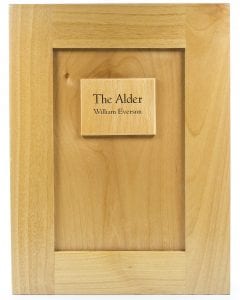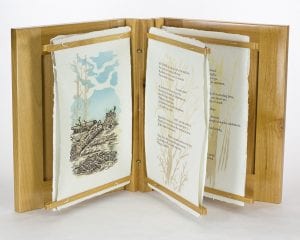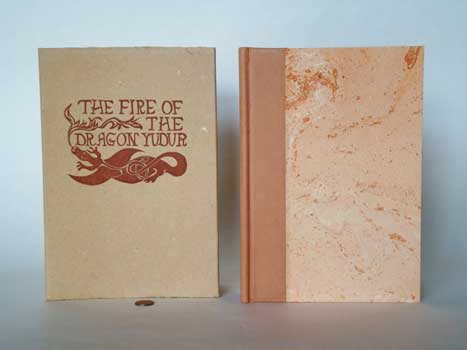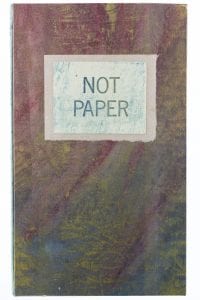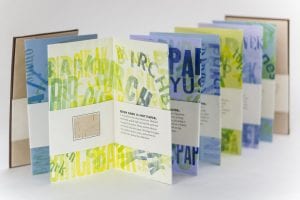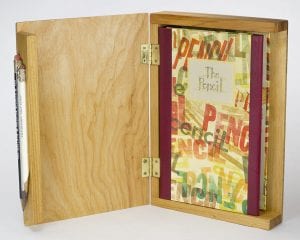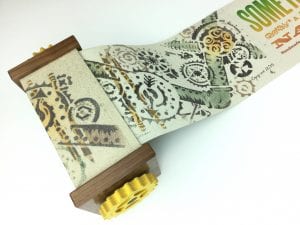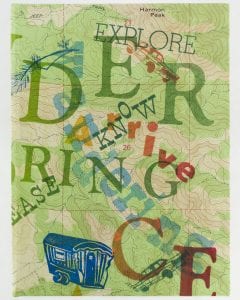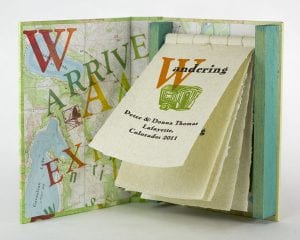Peter and Donna Thomas are authors, papermakers, and book artists. They started their careers as craftspeople at Renaissance Fairs and were inspired by their experience to become artists. They built their home, a wagon in the style of a 19th century Redding Wagon, and take it across the country where they teach book arts workshops. Since they started in 1977 they have published over 100 books, and their works have been exhibited at universities, libraries, galleries, and museums around the world. All their pieces are handcrafted, and they use a variety of materials and techniques to make each book unique.
As part of the Spotlight on Collections series, collection curator Sha Towers and exhibits coordinator Erik Swanson chose seven examples of the Thomas’ artistry to showcase in this post. Images of the books are presented below along with descriptive text reproduced from the artists’ website.
The Alder
Year: 2012
Materials: Alder Wood, Leather, Paper-Pulp, Papyrus
“The book is housed in a beige cloth covered clamshell box that has leather closures and the title, printed on a paper label, on the spine. It contains the frame-as-a-page binding of Everson’s poem. The binding is made using Alder wood harvested from the grove where Everson cut the tree described in the poem. The text is letterpress printed on Peter’s handmade paper using handset 18 pt Goudy Newstyle type. The illustrations are made with sprayed paper-pulp through stencils created by Donna Thomas.”
The Wandering Book Artists’ Collaborative Broadsides
Year: 2011
Materials: Ochre, Papyrus, Polymer Plates
“In April through October of 2010 Peter and Donna Thomas traveled around the country in their homebuilt gypsy wagon visiting libraries, book arts centers and other book artists. This book is the collection of the broadsides made on that trip.
To describe the broadsides and the collaborations, we prepared and printed a 12-page pamphlet-bound introduction. It is printed on Peter’s handmade paper, made from cotton rag colored ochre with dark t-shirt fiber inclusions. It was printed using polymer plates with Playbill and Century Schoolbook types. We wanted to document the adventure artistically, and decided we could do that by making prints and broadsides in the art studios, libraries, and book arts centers we visited. Envisioning that the broadsides would be collected together as a series, we set a few simple guidelines: they would have a common size and edition number; each print would have imagery or text that related to our gypsy wagon or our trip; and would also reflect something unique about the collaborators, their skills, or the place they lived.”
The Fire of the Dragon Yurdur
Year: 1981
Materials: Leather, Linoleum, Marbled Paper
“This is a fairy tale written and printed with friends Peter and Donna made while working at the Renaissance Pleasure Faire. Peter made the paper and Donna cut the illustrations in linoleum. The type is handset using 18-point Anglo, a modern reproduction casting of a vintage advertising type. The type was chosen for its chaotic design which complements the text, as well as for the cross inside of the lower case ‘o,’ which was reminiscent of a Goudy type used by the Grabhorns, master printers from San Francisco, in many of their books we so admired at the time.”
Not Paper
Year: 2010
Materials: Amate, Birch Bark, papyrus, Papa, Tyvek, Wasp Nest
“The text is an adaptation of our 1997 miniature book Almost paper. It is written by Peter, handset using Centaur, Neuland and old wood type, letterpress printed on Peter‘s handmade paper and handbound. There are forty-eight copies.”
Pencil
Year: 2010
Materials: Cedar, Oasis Goatskin, Papyrus
“This book is a celebration of the pencil. The text a short history of the pencil and there are vintage advertising pencils displayed in the book. The text was hand written and illustrated, and colored with pencil by Donna. The original was then color laser printed on Peter’s handmade paper for the edition. The six vintage pencils are mounted in the center of the book, held in a wooden holder that we made using pencil cedar, construct with a hand carved dovetail joint. The binding has a unique tri-fold cover, the text hidden behind the inner cover and the pencil holder. Donna executed the binding, using oasis goat leather spines and Peter’s handmade paper that he printed using antique wood type, with multiple press runs in multiple colors. The book is twelve pages long.”
Sometimes I Pretend
Year: 2014
Materials: California Walnut, Paper Pulp, Papyrus, Straight Grain Maple
“This short poem by Nye has been hand set with various sizes and fonts of wood and metal type and printed as a scroll, in multiple colors using a ‘rainbow roll,’ on Peter’s handmade paper. The paper is also illustrated with two paper pulp stenciled steam punk images made by Donna. Each image was sprayed using 4 colors of pulp through 2 or 3 stencils. The spray pulp was made from old colored rags with no added pigments. The scroll is bound in a unique box structure made with paper pulp stenciled handmade paper and California walnut. The box also features wooden sprocket cranks made from straight grain maple, inscribed with the word ‘close’ and an arrow indicating the direction to rotate the sprocket to return the scroll into the box. There is a pencil attached to the end of the scrolling text to restrain it from slipping into the box.”
Wandering
Year: 2011
Materials: Linoleum, Papyrus, Umber, Wood
“The text is an excerpt from T. S. Eliot’s poem ‘Four Quartets.’ This book was made in Lafayette, Colorado while we were teaching a class for the Book Arts League. It was letterpress printed on Peter’s handmade paper (light umber with black fiber flecks) using an unidentified type face and a linoleum cut of a gypsy wagon that was carved by Donna for this book. The binding is a variation on our flap page binding, with 3 sheets folded and sewn over a wooden dowel. The cover and endpapers were letterpress printed on old USGS topographic maps using wood and metal type, printers’ ornaments and Donna’s linoleum cut. When the flap pages are folded back an illustration is revealed.”
